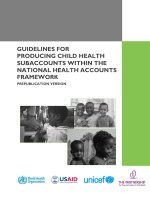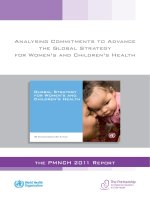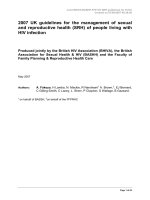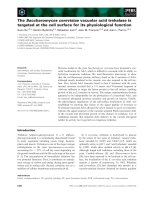Postgraduate Research Opportunities at the Telethon Institute for Child Health Research: Student project booklet 2013 docx
Bạn đang xem bản rút gọn của tài liệu. Xem và tải ngay bản đầy đủ của tài liệu tại đây (2.57 MB, 92 trang )
Postgraduate Research Opportunies
at the Telethon Instute for Child Health Research
Student project booklet 2013
Welcome to the
Telethon Instute for Child Health Research
Established in 1990, the Telethon Instute for Child Health Research
exists to improve the health of children, adolescents and their families.
We are unique in Australia. We adopt a muldisciplinary approach to
major childhood illnesses such as cerebral palsy, childhood cancers and
leukaemia, asthma and spina bida. This muldisciplinary approach is a
key strength of our research programs. It also allows the Instute to oer
a wide variety of research opportunies for postgraduate students.
The Instute is closely associated with Princess Margaret Hospital for
Children and the School of Paediatrics and Child Health at the University
of Western Australia. We are also aliated with UWA through the Centre
for Child Health Research and with the state’s other four universies.
You can nd out more about areas of research and opportunies for
students at the Instute by:
• Reading the Postgraduate Student Project Booklet. This gives a
range of suggested projects and should be considered a guide to the
opportunies available, not a denive list.
• Referring to the Instute website - www.childhealthresearch.org.au
• Contacng individual researchers for further informaon about
research projects.
• Contacng Kathy Vial for general queries on (08) 9489 7799 or email
• Aending the Prospecve Students Evening at the Instute on
Wednesday August 15th, 2012 at 4:00pm.
Stan and Jean Perron Awards (for research conducted principally at TICHR)
With the support of the Stan Perron Charitable Foundaon, since 2005 the Telethon Instute for Child Health Research
(TICHR) has established several presgious awards aimed at supporng exceponal postgraduate research students who
are undertaking their research at the Instute.
Stan and Jean Perron Scholarships
These Scholarships accompany PhD scholarships which commence in 2013 and are won by the recipients through their
enrolling Universies in a separate applicaon process. The amount will be $5000 per year each for the duraon of the
scholarship, paid in conjuncon with that scholarship.
To be eligible for consideraon, a student has to enrol full-me for a research higher degree (PhD or equivalent) at
the University, and conduct the research principally within the Instute under the supervision of one or more of the
Instute’s researchers. This Scholarship is supplementary to a scholarship awarded to the student through the University.
Successful applicants must have First Class Honours (or equivalent) and have been awarded an APA. At least three
awards will be given in 2013 and applicaons will be judged on merit.
For more informaon or a copy of the applicaon form please contact:
Kathy Vial, Academic Services Manager, Telethon Instute for Child Health Research By mail: PO Box 855 West Perth WA
6872, or by email (), or by fax (08 9489 7700). (For telephone enquiries: 08 9489 7799).
Applicaon due date: Friday 2nd November 2012.
Reminder: Requirement for Concurrent Scholarship. Applicants are also required to have submied an applicaon form
for the Australian Postgraduate Awards/University Postgraduate Awards directly to the relevant University Scholarships
Oce (or equivalent) by the specied closing date (Wednesday 31st October 2012, for UWA).
Stan and Jean Perron Award for Excellence
Students intending to enrol in a PhD at the Instute may be
interested to know of the Stan and Jean Perron Award for
Excellence. The Award is designed to recognise outstanding
research performance whilst a student is undertaking
research at the Instute. The Award has the value of $5000
for one year, and will be awarded to the research higher
degree student whose performance is deemed the best in
the preceding 12 months. More than one award may be
made in any year.
If you’d like further informaon, please contact:
Kathy Vial
Academic Services Manager
Aboriginal health
Our Aboriginal researchers work
with Aboriginal communies to help
children overcome the many hurdles
they face - higher rates of pre-term
birth, lower birth weight, SIDS,
infecous diseases and emoonal
and behavioural problems.
Bioinformacs and data services
Bioinformacs is an excing and
relavely new eld of science,
encompassing the branch of life
science that applies informaon
technology to the eld of biology
to help understand various
biological processes. The primary
goal of bioinformacs is to increase the
understanding of biological processes.
Child development and wellbeing
There is a broad range of interacng
factors that aect children’s
development and wellbeing.
Thousands of families are helping
us as we invesgate language
dicules, school readiness, and
pathways to health and wellbeing.
Diabetes, obesity and related
disorders
Our researchers are conducng
research which aims to improve the
lives of children and adolescents
living with diabetes, obesity and
other endocrine condions. Children
with Type I diabetes require insulin
injecons every day for the rest of
their lives. Related to the increasing rates of
childhood obesity is type 2 diabetes in children.
Asthma, allergy & respiratory
disease
We are looking at the environmental
and biological factors that could
be linked to asthma, as well as the
eects of UV light and vitamin D on
the immune system. Our researchers
are also working on improved
treatments for children with cysc
brosis and working towards prevenng
this disease.
Children’s cancer and
leukaemia
Leukaemia is the most common
cancer in children and our research
focus is on why some children don’t
respond to therapy and relapse. We
are invesgang paediatric brain
tumours and ways to reduce their
devastang impact. We are also
looking at the genec, dietary and environmental risk
factors for childhood cancer.
Datasets and cohort studies
The Telethon Instute has a range
of long-term studies to expand our
knowledge on all aspects of child
health. A number of databases
underpin our populaon-based
research and these can now be linked
to other datasets to provide a more
complete picture of child health.
Disability and developmental
disorders
From concepon through
childhood, our research into
disabilies and developmental
disorders encompasses any
condion that disrupts ‘typical’
child development. We are looking
are Down Syndrome, Re syndrome,
Ausm Spectrum Disorders, birth
anomalies, cerebral palsy and Fetal Alcohol
Spectrum Disorder.
Research areas
Drug discovery
Our Drug Discovery Technology
Group is focused on developing new
therapies to target disease-causing
interacons between proteins; both
inside and outside of cells, as well
as the development of ‘mimec’
vaccines against disconnuous
epitopes.
Genec impacts on health
Our researchers are world leaders
in the applicaon of genec and
metabolomic approaches to idenfy
biological markers of complex disease,
helping us to nd beer treatments
and ways of prevenng disease.
Modern research tools allow us to
look at all of our genes, to idenfy genec
and metabolic biomarkers of complex
diseases like infecons and diabetes.
Infecous disease
Worldwide, 10 million children
under the age of ve die from
infecon each year. Our infecous
disease researchers are involved in
understanding the inner workings
of disease, including the pathway
from immunity to infecon; disease
surveillance; risk factors in the development
of disease; vaccine development and trials.
Pregnancy and maternal health
Emerging research is focusing on
pregnancy as a crucial me in
determining of the future health and
wellbeing of the child. We are looking
at mulple factors during pregnancy
that can inuence the way in which
the unborn child is programmed
for future life outside the womb
including maternal lifestyle factors such as stress,
hypertension, substance use, nutrion and obstetric risk.
Environmental impacts on
health
The physical environment, which
includes diet, housing and polluon,
can have a large impact on child
health and disease. These can aect
health at all stages of childhood
development. Our researchers use
spaal epidemiology, data linkage
and polluon monitoring to beer understand
environmental inuences on childhood health.
Impacts on policy and
pracce
One of the aims of the Telethon
Instute is to improve the health
of all children by translang
research outcomes to inuence
public health policy. Our impact on
health policy and pracce in the last
decade has been signicant including
mandatory forcaon of breadmaking our with
folate to prevent neural tube defects and the Western
Australian Aboriginal Child Health Survey.
Mental health
Around one in ve Australian
children will develop some form
of behavioural problem by the
me they reach adulthood. Poor
mental health in childhood is a
signicant predictor of mental health
problems later in life and also impacts
negavely on physical health and
school achievement. Much of our work is dedicated to
understanding how mental health problems develop and
working towards mental illness prevenon.
For more informaon about our research areas, visit
www.childhealthresearch.org.au
1
TableofContents
ABORIGINALHEALTH 4
WhatleadstogoodoutcomesinhealthandwellbeingforAboriginalchildrenandyouth? 5
Connectingculture,curriculumandcommunitiesinearlyyear’sAboriginaleducation. 6
CulturalSecurityinAboriginalhealthservicedelivery:AnauditofNMHS 7
StrengtheningsocialandemotionalwellbeingofAustralianAboriginalpeople
:Howdoes
racialidentityandrelatedself‐esteemmediatethementalwellbeingofAboriginalpeople?.8
PerinatalmentalhealthforAboriginalFamilies:Acommunityinitiative 9
Indicatorsofsuccessandwellbeingof'moorditj'urbanIndigenousWestAustralians 10
ASTHMA,ALLERGYANDRESPIRATORYDISORDERS 11
Rhinovirusi
mpairsphysiologicallungdevelopment 12
Predictingthesafetyofairtravelinex‐prematureinfants 13
Dendriticcellsandtheinductionofallergicairwaysinflammation 14
TypeIInterferonimmunomodulationofallergicasthma 15
VitaminDdeficiencyalterslungdevelopment 16
Understandinglungdevelopmentdu
ringpuberty 17
Optimisedexpressionandcharacterisationofrecombinanthumanrhinoviruscapsid
proteins 18
Immunecharacterisationofnovelcatallergens 19
HumanrhinovirustypeC(HRV‐C) immuneresponsesinasthma 20
Theaerobiologyofnovelcatallergens 21
RoleofIRF7genenetworksinasthma 22
BIOINFORMATICSANDDATASERVICES 23
Evaluationsofvirtualmachineperform
anceforNextGenerationSequencingplatforms 24
Investigatingchildhoodbraintumoursbyintegratingof'omicsplatformsusing
Bioinformatics 25
Developingadvancedbioinformaticstechniquesforstoringandanalysingnext‐generation
sequencingdata 26
CHILDREN’SCANCERANDLE
UKAEMIA 27
Paediatricbraintumourmodeldevelopmentandpreclinicalassessmentofnovel
therapies 28
Immunitytomelanoma 29
CHILDDEVELOPMENTANDWELLBEING 30
Pathwaystopreventableandunexplaineddeathsinchildhoodandyoungadulthoodin
WesternAustralia 31
TheBuiltEnvironmentandChild HealthandDevelopment 32
PhysicalActiv
ityintheEarlyYears 33
Schoolreadiness:Theimpactofbirth,parentalandcommunitycharacteristics 34
Pathways,PoliciesandPrevention:BetterEducationalOutcomesforWestern
AustralianChildren 35
Long‐terminfluenceofearlynutritiononmetabolichealthORAnalysisofmetabolicprofiles
inadolescentsbymassspectrometry‐basedme
tabolomics:biomarkersformetabolic
consequencesofearlyprogramming(scientifictitle) 36
DATASETSANDCOHORTSTUDIES(Noprojectsin2013) 37
DIABETES,OBESITYANDRELATEDDISORDERS 38
ExploringperinatalcomplicationsseeninacontemporaryType1Diabetescohort 39
Psychologicalprofileofobeseadolescentsu
ndertakinglifestylechange 40
Attitudestowardsbariatricsurgeryamongparentsofchildrenaccessingalifestyle
interventionprogramforobesity 41
2
ExploringperinatalcomplicationsseeninacontemporaryType1Diabetescohort 42
Analysisofhypoglycaemiaunawarenessinadolescents duringthefirst18months
afterdiagnosisoftype1diabetes 43
Transitionofpatientswithendocrinediseasefrompaediatricandadolescentinto
adultcare 44
TheimpactoftheBioente
ricsIntragastricballoononpsychologicalwell‐beingofobese
adolescents 45
Astudyofsleepdisturbances,highbloodpressureandmetabolicabnormalitiesin
youngadults:the‘FinapresSleepStudy’ 46
DISABILITYANDDEVELOPMENTALDISORDERS 47
AccommodationforyoungadultswithDownsyndrome 48
Combiningalarg
esamplewithapopulationdatabase–AussieRettandIn terRett 49
ContinenceandRettsyndrome 50
HowarefamiliesofgirlswithRettsyndromerespondingtoresearchsuggestingthatthe
symptomsofRettsyndromemightbepreventedorhaltedwithadvancesinmedical
knowledge? 51
Onlinesurveyofgastro‐intestinalissuesandmana
gementinRettsyndrome 52
MECP2duplications:anewcauseofintellectualdisability 53
Comparisonofparent‐reportandMedicaredatainalongitudinalstudy 54
LongitudinalmodellingofRettsyndromeseverityusingquestionnaireandvideodata 55
Socio‐economicdifferencesandparentalsatisfactionwithservicesinRet
tsyndrome
andDownsyndrome 56
TrendsinprevalenceofintellectualdisabilityintheAboriginalpopulationinWA 57
Thecostofchildhoodintellectualdisabilityandautismspectrumdisorderwithout
intellectualdisabilityinWesternAustralia:Acost‐of‐illnessstudy 58
DRUGDISCO
VERY(Noprojectsin2013) 59
ENVIRONMENTALIMPACTSONHEALTH 60
Spatialanalysisofmalereproductivecongenitalanomalies 61
Sunlight,vitaminD andinflammatorydisease 62
PeelChildhealthstudy 63
Theexacerbationofrespiratoryvirusesbygeogenicdust 64
Theroleofepigeneticsinarsenicinducedlungdisea
se 65
TheMentalHealthofAdultswhowereExposedtoAsbestosinChildhood 66
GENETICIMPACTSONHEALTH 67
Mechanismsofparasiticmodulationofthehumanepigenome 68
Characterisingtheroleofepigeneticsinhypospadias 69
IMPACTONPOLICYANDPRACTICE(Nopro
jectsin2013) 70
INFECTIOUSDISEASE 71
Functionalcharacterisationofgenesassociatedwithotitismediasusceptibility
inchildhood 72
Maternalprenatalstressexposureandpoorhealthandwellbeingforoffspringin
childhoodandearlyadolescence 73
IdentifyingRiskFactorsforSevereOtitis MediainWesternAus
tralianChildren 74
Immunitytorhinovirusinotitis‐pronechildren 75
AntecedentsandconsequencesofinvasivepneumococcaldiseaseinWesternAustralia 76
Identifyingopportunitiesforpreventingrespiratoryinfectionsinchildren
throughintegratingpopulation‐basedhealthandlaboratorydata 77
Metabolomicstocharacterizehost‐pathogeninteractionsinba
cterialinfections. 78
MENTALHEALTH(Noprojectsin2013) 79
PREGNANCYANDMATERNALHEALTH(Noprojectsin2013) 80
3
PRINCESSMARGARETHOSPITALFORCHILDREN 81
AssessmentofrespiratoryfunctioninchildrenwithNeuromusculardisease 82
EvaluationofapilotgroupprogramforpaediatricChronicpainpatients 83
SCHOOLOFPAEDIATRICSANDCHILDHEALTH 84
RecurrenceofhumanrhinovirusgroupCinchildrenthatsuffermultipleasthmaattacks 85
Contributionofgenevariationstoasthmaatta
ckseverity 86
ABORIGINAL HEALTH
5
TitleofProject WhatleadstogoodoutcomesinhealthandwellbeingforAboriginal
childrenandyouth?
KeyResearchArea Aboriginalhealth
ResearchGroup DevelopmentalPathwaysProject
StartDate August2012
ChiefSupervisor ProfessorSteveZubrick(TICHR)
OtherSupervisors DrRebeccaGlauert,DrErikaHagemann(TICHR)
ProjectOutline The aim of this study is to examine protective factors and resilience that
contributetogoodeducationaloutcomes,lowermortalityandmorbidityand
lesscontactwiththejuvenilejusticesysteminAboriginalchildrenandyouth
in Western Australia.The present study is part of the Developmental
PathwaysinWAChildrenProject(DPP)ledbytheTelethonInstituteforChil d
HealthResearch.Thestudywillbuilduponthefindingsofpreviousresearch
conductedattheInstituteandwithintheDPPonAboriginalhealth.Aspartof
the DPP it will be able to access and link population level data related to
health,education,disabilityservices,mentalhealthandjuvenilejustice.
Projectsuitablefor Honours Masters PhD
EssentialQualifications ForPhDcandidates:aminimumof2AHonoursdegreeoraMastersdegreein
arelatedfield.
EssentialSkills Backgroundknowledgeinrelevantareas,suchasAboriginalhealth,
developmentalhealth,psychology,disability,medical
sociology/anthropology,socialepidemiologyandpopulationhealth.
Knowledgeofquantitativedataanalyses.
AdditionalSkills Experienceintheanalysesoflinkeddatasetswouldbeadvantageousbutnot
essential.
Funding ApplicantshouldapplyforAPA,UPAorotherscholarship
Top‐upscholarshipavailable
Fullscholarshipavailable
Contactforfurther
information
NameDrRebeccaGlauert
Email
Telephone94897754
6
TitleofProject Connectingculture,curriculumandcommunitiesinearlyyear’sAboriginal
education.
KeyResearchArea Aboriginalhealth
ResearchGroup PindiPindi&Murdoch
StartDate August2013
ChiefSupervisor A/ProfessorLibbyLeeHammond(Murdoch)
OtherSupervisors A/ProfessorCherylKickett‐Tucker(Pindi/Murdoch)
A/ProfessorLibbyMatthews(Murdoch)
ProjectOutline The project will enable Aboriginal children from four urban school
communities to participate in an outdoor learning program that supports
their wellbeing, cultural identity and connection to country whilst enabling
educators to make mean ingful links with children’s community, the Early
YearsLearningFrameworkandtheNationalCurriculum.Outdoorlearningin
earlychildhoodisaconceptthatisgainingmomentuminEurope,theUKand
the USA. Few Western Australian schools adopt a rigorous program of
learninginoutdoorenvironments.Thisprojectwillinvestigatetheimpactof
extended outdoorlearning opportunities on Aboriginalchildren’s wellbeing,
culturalidentity,curriculumoutcomesandattendance.
AIMS:
1/Improved attendance, well‐being, cultural identity and curriculum
outcomesforAboriginalchildren.
2/Developmentofasuccessfulmodelforculturalsecurityineducation.
3/StrongrelationshipsbetweenschoolsandlocalAboriginalcommunity.
4/Improvedculturalcompetenceofearlychildhoodeducators.
Projectsuitablefor Honours Masters PhD
EssentialQualifications
EssentialSkills
AdditionalSkills
Funding ApplicantshouldapplyforAPA,UPAorotherscholarship
Top‐upscholarshipavailable
Fullscholarshipavailable
Contactforfurther
information
NameLibbyLeeHammond
Email
Telephone93602627
7
TitleofProject CulturalSecurityinAboriginalhealthservicedelivery:AnauditofNMHS
KeyResearchArea Aboriginalhealth
ResearchGroup PindiPindi
StartDate egMarch2013
ChiefSupervisor A/ProfessorJuliCoffin(Pindi)
OtherSupervisors A/ProfessorCherylKickett‐Tucker(Pindi)
ProjectOutline The project aims to explore the concept of “cultural security” within the
PublicHealthDirectorateoftheNorthMetropolitanHealthServiceofPerth,
WesternAustralia.UsingCoffin’s(2007)culturalsecurityscaleasa guide,itis
theintention of thisresearch tomap theexisting PublicHealth Directorate.
Usingthisinformation,itisthepurposeofthisprojecttodevelopacultural
security framework that can be implemented and with which an audit tool
can be developed and evaluated.Thisproject proposesto assistthe North
MetropolitanHealthServicetomovealongthecontinuumofCoffin’s(2007)
scale that may result in strengthening the cultural security of public health
servicestoAboriginalWesternAustralians.
UsingCoffin’s(2007)scaleofculturalsecurity,thisprojectwillundertakea
mapping exercise of the Public Health Directorate as well as qualitative
interviews.Forthequalitativephaseoftheproject,aninterviewguidewillbe
developed to explore the concept of “cultural security” as it applies in a
health care setting and with an emphasis on the access to services at the
NorthMetropolitanHealthServices.
Projectsuitablefor Honours Masters PhD
EssentialQualifications ResearchHigherDegreeinhealth,education,SocialSciencesorarelated
degree
CurrentCclassdriver’slicense
CurrentNationalPoliceClearance
EssentialSkills KnowledgeofAboriginalcultureandexperienceworkingwithAboriginal
people.
KnowledgeofandexperiencewithcurrentissuesandtrendsfacingAboriginal
people.
Experienceworkinginaresearchenviro nment
Demonstratedresearchexperienceinqualitativedataanalysis(e.gNVIVO)
AdditionalSkills
Funding ApplicantshouldapplyforAPA,UPAorotherscholarship
Top‐upscholarshipavailable
Fullscholarshipavailable
Contactforfurther
information
NameCherylKickett‐Tucker
EmailC.Kickett‐
Telephone0427778086
8
TitleofProject StrengtheningsocialandemotionalwellbeingofAustralianAboriginal
people:Howdoesracialidentityandrelatedself‐esteemmediatethe
mentalwellbeingofAboriginalpeople?
KeyResearchArea Aboriginalhealth
ResearchGroup PindiPindi
StartDate 30July2012
ChiefSupervisor A/ProfessorCherylKickett‐Tucker(PindiPindi/TICHR/Murdoch)
OtherSupervisors
ProjectOutline The studyaims to explorethe developmentof racialidentity and related
self‐esteemofAboriginalchildren,youthandadultsacrossthelifespan.Itis
the intention of this research to describe the mediating factors of racial
identity and related self‐esteem that influence Aboriginal people’s mental
wellbeing. This project proposes to strengthen the social, cultural and
emotionalwell‐beingofAboriginalchildrenaged4‐12years,youthaged13‐
17andadultsfrom18yearsonwards.
This study will pilot a suite of 4 psychosocial instruments called I‐RISE
(IndigenousRacialIdentityandSelf‐Esteem)andtrialIRISE_Cfor8‐12yearold
Aboriginalchildren. Thisstudy willemploy both quantitativeandqualitative
methods.
Projectsuitablefor Honours Masters PhD
EssentialQualifications
ResearchHigherDegreeinhealth,education,SocialSciencesora
relateddegree
NationalPoliceClearance
CurrentWADriversLicence
CurrentWorkingWithChildrenCheck
EssentialSkills
AdditionalSkills
KnowledgeofAboriginalcultureandexperienceworkingwith
Aboriginalpeople.
Knowledgeofandexperiencewithcurrentissuesandtrendsfacing
Aboriginalpeople.
Demonstratedresearchexperiencein:
‐quantitativedataanalysis(egusingSPSS orSAS)and
‐qualitativedataanalysis(e.gNVIVO)
Funding ApplicantshouldapplyforAPA,UPAorotherscholarship
Top‐upscholarshipavailable
Fullscholarshipavailable
Contactforfurther
information
NameCherylKickett‐Tucker
EmailC.Kickett‐
Telephone0427778086
9
TitleofProject PerinatalmentalhealthforAboriginalFamilies:Acommunityinitiative
KeyResearchArea Aboriginalhealth
ResearchGroup PindiPindi
StartDate August2012
ChiefSupervisor A/ProfessorCherylKickett‐Tucker(PindiPindi/Murdoch)
OtherSupervisors ProfessorRhondaMarriott(TICHR/UWA)
ProjectOutline The study isa participatoryaction research designand willhave 4 discrete
phases‐(1)consultation and recruitment; (2) construct development and
culturalvalidation;(3)programdevelopmentandpiloting;and(4)Evaluation.
The study will include a strong emphasis on prevention, promotion and
education. A major aim of the study is to build the capacity of Aboriginal
families and communities to deal effectively with a range of mental health
andotherissuesassociatedwithnewparenthood.Althoughacorethemeof
theprojectisperinataldepression,theprimefocuswillbeoncontributorsto
positiveexperiencesofnewparenthood.
Projectsuitablefor Honours Masters PhD
EssentialQualifications
ResearchHigherDegreeinhealth,education,SocialSciencesora
relateddegree
CurrentCclassdriver’slicense
CurrentNationalPoliceClearance
EssentialSkills KnowledgeofAboriginalcultureandexperienceworkingwithAboriginal
people.
KnowledgeofandexperiencewithcurrentissuesandtrendsfacingAboriginal
people.
Experienceworkinginaresearchenviro nment
Demonstratedresearchexperiencein:
•quantitativedataanalysis(egusingSPSSorSAS)and
•qualitativedataanalysis(e.gNVIVO)
AdditionalSkills
Funding ApplicantshouldapplyforAPA,UPAorotherscholarship
Top‐upscholarshipavailable
Fullscholarshipavailable
Contactforfurther
information
NameCherylKickett‐Tucker
EmailC.Kickett‐
Telephone0427778086
10
TitleofProject Indicatorsofsuccessandwellbeingof'moorditj'urbanIndigenousWest
Australians
KeyResearchArea Aboriginalhealth
ResearchGroup PindiPindi
StartDate 30July2012
ChiefSupervisor A/ProfessorCherylKickett‐Tucker(PindiPindi)
OtherSupervisors
ProjectOutline The principal purpose of the project is to discover the meaning of success,
resilience and wellbeing from the perspective of 'accomplished' urban
Indigenous West Australians.From this information, the secondary project
aim is to highlight the factors that contribute to wellbeing, resilience and
success,includingthedifferencesandsimilaritiesbetweentheconstructs.
Qualitative inquiry combined with an interpretive paradigm will be used to
explore the meanings and indicators of success and wellbeing of
'accomplished' urban Indigenous West Australians.To ensure we 'capture
theessenceofmeanings",theprojectwillutiliseasemi‐structuredinterview
schedulewhichwillbeemployedinapersonalandconversationalmanner.
Projectsuitablefor Honours Masters PhD
EssentialQualifications ResearchHigherDegreeinhealth,education,SocialSciencesorarelated
degree
CurrentCclassdriver’slicense
CurrentNationalPoliceClearance
EssentialSkills KnowledgeofAboriginalcultureandexperienceworkingwithAboriginal
people.
KnowledgeofandexperiencewithcurrentissuesandtrendsfacingAboriginal
people.
Experienceworkinginaresearchenviro nment
Demonstratedresearchexperienceinqualitativedataanalysis(e.gNVIVO)
AdditionalSkills
Funding ApplicantshouldapplyforAPA,UPAorotherscholarship
Top‐upscholarshipavailable
Fullscholarshipavailable
Contactforfurther
information
NameCherylKickett‐Tucker
EmailC.Kickett‐
Telephone0427778086
ASTHMA, ALLERGY AND
RESPIRATORY DISEASE
12
TitleofProject
Rhinovirusimpairsphysiologicallungdevelopment
KeyResearchArea
Asthma,allergyandrespiratorydisorders
ResearchGroup
Lunggrowthandrespiratoryenvironme ntalhealth
StartDate
Early2013
ChiefSupervisor
DrAlexanderLarcombe(TICHR)
OtherSupervisors
A/ProfessorGraemeZosky(TICHR)
MrLukeBerry(TICHR)
ProjectOutline
Ourviewofhumanrhinovirus (HRV)haschanged;oncethoughttobeamere
harmless pathogen, responsible only for the “common cold”, HRV is now
knowntoaccountforalmostallexacerbationsofasthmainbothchildrenand
adultsaswellasexacerbationsofotherrespiratoryconditions.EarlylifeHRV
infectionmaybeespeciallyharmful,particularlywhencombined withallergic
sensitization, providing a causal link to persistent asthma. The recent
development of a mouse model of HRV infection has opened the door for
research into the physiological and immunological consequences of HRV
infection.
The general aim of this project is to investigate the links between HRV
infection and impairedphysiological lung growth and development.We will
employ mouse models and an array of sophisticated techniques to identify
relationshipsbetweenearlylifeHRVinfectionandaltereddevelopmentofthe
respiratorysystem.By thisapproachwewill provide animportantfirststep
towards the ultimate, long‐term goal of our research which is to develop
strategiestopreventorameliorateHRVexacerbatedrespiratoryillness.
TechniquesUsed:
MousemodelsofHRVinfection;
Lungfunctionanalysis;
Lungstructureassessment/stereology;
Assessmentofcellularinflammation.
Projectsuitablefor Honours Masters PhD
EssentialQualifications BScorequivalent
EssentialSkills Aboveaveragewrittenandoralcommunicationskills;
Motivation;
Abletoworkaspartofateam.
AdditionalSkills Someknowledgeorrespiratoryphysiology;
Someknowledgeofstatistics.
Funding ApplicantshouldapplyforAPA,UPAorotherscholarship
Top‐upscholarshipavailable
Fullscholarshipavailable
Contactforfurther
information
Name–DrAlexanderLarcombe
Email–
Telephone–(08)94897814
13
TitleofProject Predictingthesafetyofairtravelinex‐prematureinfants
KeyResearchArea Asthma,allergyandrespiratorydisorders
ResearchGroup PaediatricRespiratoryPhysiology
StartDate Immediate
ChiefSupervisor ProfGrahamHall(TICHR)
OtherSupervisors MaureenVerheggen(PMH)
ProjectOutline Infants with a history of premature birth may develop respiratory distress
duringairtravel.Ahypoxiatestisusedtoassessanindividual’stolerancetoa
low oxygen environment, such as that encountered during commercial air
travel.Thosefailingthehypoxiatesteitherdelaytravel,orareprovidedwith
supplementaloxygenduringtheflight.Thehypoxiatesthasbeenvalidatedin
olderchildrenandadults;converselyworkfromourgroupsuggeststhetestis
notsuitable in veryyoung infants.This project aimsto validate thehypoxia
test in older infants by performing hypoxia tests and monitoring in‐flight
oxygensaturationininfantswithahistoryofprematurebirth .
Theobjectivesoftheprojectaretoinvestigatetheabilityofthehypoxiatest
topredicttheresponseofinfantstoairtravel.
Wehypothesisethat:
1. The accuracy of the hypoxia test to predict in‐flight hypoxia in ex‐
prematureinfantswillimprovewithincreasingage.
2.Severityofneonatallungdiseaseintheperinatalperiodisariskfactorfor
in‐flighthypoxia.
Projectsuitablefor Honours Masters PhD
EssentialQualifications BScorMBBS;medicalundergraduateswishingtoundertakeaBMedScialso
suitable.
EssentialSkills Abilitytoworkwithinfants andfamilies
AdditionalSkills
Funding ApplicantshouldapplyforAPA,UPAorotherscholarship
Top‐upscholarshipavailable
Fullscholarshipavailable
Contactforfurther
information
ProfGrahamHall–
14
TitleofProject Dendriticcellsandtheinductionofallergicairwaysinflammation
KeyResearchArea Asthma,allergyandrespiratorydisorders
ResearchGroup CellBiologyandImmunology
StartDate February2013
CoSupervisors DrVanessaFear(TICHR)
OtherSupervisors DrDeborahStrickland(TICHR)
ProjectOutline Initial development of atopic asthma is strongly linked with viral infection
early in life, and more recently delayed development of innate immunity,
includingtheantiviralcytokineTypeIInterferon.
The normal adaptive immune response to inhal ed antigen is initiated by
airway dendritic cells (DC) and leads to the generation of immunologic
tolerance. During asthma the dendritic cell response to usually innocuous
antigens/allergensresultsinairwaysinflammationanddevelopmentofaTh2
memory cell response. This Th2 memory cell response is the underlying
mechanismresponsibleforasthma.Thisprojectwillinvestigatetheimpactto
type I IFNs on the deve lopment of bone‐marrow derived dendritic cell
culturesandtheirabilitytoinduceanimmuneresponseinvivo.Dendriticcells
will be characterised with regard to maturation, phenotype, tissue homing
capacity,andinductionofinflammatoryresponses.
Techniquesused:
Animalmodelsofdisease;Tissuepreparation;Tissueculture;Flowcytometry;
Cellsorting;Histology;ELISA;Immunexassay;Proliferationassays;
Fluorescentlabellingofcellsandcelltransfer.
Thisprojectissuitable
for
Honours Masters PhD
EssentialQualifications BSc
EssentialSkills
AdditionalSkills
Funding ApplicantshouldapplyforAPA,UPAorotherscholarship
Top‐upscholarshipavailable
Fullscholarshipavailable
Contactforfurther
information
Name–DrVanessaFear
Email–
Telephone–94897836
15
TitleofProject TypeIInterferonimmunomodulationofallergicasthma
KeyResearchArea Asthma,allergyandrespiratorydisorders
ResearchGroup CellBiologyandImmunology
StartDate February2013
Supervisor DrVanessaFear(TICHR)
OtherSupervisors DrDeborahStrickland(TICHR)
ProjectOutline Asthmaisachronicdiseaseeffectingover12%oftheAustralianpopulation.
Recent data strongly indicates that asthmatics experiencing severe viral
exacerbationofdisease,requiringhospi talization,aredeficientintheirtypeI
Interferonresponse.ThetypeIInterferons(IFNs)areexpressedearly in the
innate immune response to viral challenge, induce antiviral responses and
alertsurroundingcellstothepresenceofpathogen.
Current scientific evidence determining the reduced type I Interferon
expressionin asthmatics hasbeenlimited totwotypeI Interferonsubtypes
viz.IFNa2and IFNb. Inhumans, however,there are over14type Interferon
subtypes,including13IFNasubtypesandtwoisoformsoftheIFNb.
This laboratory has a panel of Type I IFN subtypes for investigation of
immunomodulation of asthmatic diseasein amurine modelof asthma.The
efficacyandunderlyingmechanismsoftheIFNsubtypeswillbeinvestigated.
Techniquesused:
Animalmodelsofdisease;Tissuepreparation;Tissueculture;Flowcytometry;
Cell sorting; Histology; ELISA; Immunex assay; molecular biology, cell
signalling;andDNAgenetherapy.
Thisprojectissuitable
for
Honours Masters PhD
EssentialQualifications BSc
EssentialSkills Cellbiology;molecularbiology;immunology
AdditionalSkills
Funding ApplicantshouldapplyforAPA,UPAorotherscholarship
Top‐upscholarshipavailable
Fullscholarshipavailable
Contactforfurther
information
Name–DrVanessaFear
Email–
Telephone–94897836
16
TitleofProject VitaminDdeficiencyalterslungdevelopment
KeyResearchArea Asthma,allergyandrespiratorydisorders
ResearchGroup LungGrowthandRespiratoryEnvironmentalHealth
StartDate March2013
ChiefSupervisor A/ProfessorGraemeZosky(TICHR)
OtherSupervisors MsRachelFoong(TICHR)
ProjectOutline The second half of the 20th century saw a substantial increase in the
prevalence of asthma in western countries. Recent changes in lifestyle
characterisedbyalackofoutdooractivityhaveraisedconcernsregardingthe
prevalenceofvitaminDdeficiencyinmanycountriesincludingAustralia.The
parallelsin these observations, andthe importanceofvitaminD in immune
regulation,haveleadresearcherstosuggestthatvitaminDdeficiencymaybe
to blame for the incr ease in asthma prevalence. This is supported by
epidemiologicalstudieslinkingcirculatingvitaminDlevelsandlungfunction
and limited animal work suggesting that vitamin D is involved in the
regulation of lung growth. The aim of this project is to investigate the link
betweenvitamin Ddeficie ncyandalterationsin lunggrowth usinga mouse
model. We hypothesise that vitamin D deficiency results in altered lung
development by modulating the transforming growth factorβ(TGF‐β)
pathway.
Specificallywewilldetermine:
1.IfvitaminDdeficiencyalterslungfunctionandstructure,
2.IfvitaminDdeficiencyalterexpression ofthe TGF‐β pathway during lung
development,
3.Whetherthetimingofdeficiencyduringdevelopmentaltersoutcome,
Wewilladdresstheseaims using a physiologically relevant mousemodelof
vitamin D deficiency in conjunction with state of the art techniques for
measuringlungvolume,lungmechanicsandlungstructureinmice.
Projectsuitablefor Honours Masters PhD
EssentialQualifications BSc
EssentialSkills
AdditionalSkills
Funding ApplicantshouldapplyforAPA,UPAorotherscholarship
Top‐upscholarshipavailable
Fullscholarshipavailable
Contactforfurther
information
Name:A/ProfessorGraemeZosky
Email:
Telephone:94897814
17
TitleofProject Understandinglungdevelopmentduringpuberty
KeyResearchArea Asthma,allergyandrespiratorydisorders
ResearchGroup LungGrowthandRespiratoryEnvironmentalHealth
StartDate March2013
ChiefSupervisor A/ProfessorGraemeZosky(TICHR)
OtherSupervisors ResAssistProfPeterNoble,DrAlexanderLarcombe,DrAnthonyBosco
ProjectOutline Thelunggrowsinresponsetoincreasing(absolute)metabolicdemandswith
age. An increase in lung size can occur by simple expansion and/or an
increase in the number of functionallung units (alveoli). Historically,it was
thoughtthatthemammalianlunghadlimitedcapacitytoproduceadditional
alveolipostnatally.However,recentstudieshavesuggestedotherwiseandit
is now clear that additional alveoli may appear into early adulthood. This
observationsuggeststhatpostnatallunggrowthisadynamicprocess.
The relationship between lung size, lung function and age is typically
modelled as a smooth, monotonic and strictly increasing relationship
whereby lung size and function incr ease with age and peak in early
adulthood. However, based on recent data, it is clear that the relationship
betweenlungstructure,function,bodysizeandageismuchmorecomplex.
Studiesinourlaboratorysuggestthattheremaybesubstantialremodellingin
thelungduringpubertywherebylungmechanicschangesignificantlywithout
a corresponding change in lung volume. This previously undescribed
phenomenon has implications for 1) the current dogma that the lung has
limited capacity to respond to significant structural insults and, 2) the
susceptibilityofthelungtoinsultsduringpuberty.
In this project the student will have the opportunity to characterise and
identify the mechanisms controlling the changes in lung structure and
functionthatoccurduringpubertyusingamouse model.
Projectsuitablefor Honours Masters PhD
EssentialQualifications BScorBSc(Hons)
EssentialSkills
AdditionalSkills
Funding ApplicantshouldapplyforAPA,UPAorotherscholarship
Top‐upscholarshipavailable
Fullscholarshipavailable
Contactforfurther
information
Name:A/ProfessorGraemeZosky
Email:
Telephone:94897814
18
TitleofProject Optimisedexpressionandcharacterisationofrecombinanthuman
rhinoviruscapsidproteins
KeyResearchArea Asthma,allergyandrespiratorydisorders
ResearchGroup MolecularPaediatricsGroup
StartDate Early2013
ChiefSupervisor A/ProfessorBelindaHales(TICHR)
OtherSupervisors DrTatjanaHenrich(TICHR)
ProfessorWayneThomas(TICHR)
ProjectOutline Human rhinoviruses (HRV)are strongly associated with the development of
asthmaandasthmaexacerbationsinsusceptiblechildren.Amajorobstaclein
investigating anti‐HRV immunity is a lack of standardised defined reagents.
Rhinovirus isolates cluster into three main species HRV‐A, B and C and our
studies have shownhigh IgG1antibody titrescanbe detectedwithspecies‐
specific viral capsid proteins. The capsid proteins VP1 and VP4 of all three
specieshavebeenproducedinourlaboratoryasfusionproteinsinbacterial
(Escherichia coli) and yeast (Pichia pastoris) expression systems, however
eithertheyieldsorthestabilityoftheantigenshavebeenlow.
Theaimofthis projectistooptimisetheexpressionofallviralcapsidproteins
(VP1, VP2, VP3 and VP4) of HRV and characterise the type of immune
responses to the viral proteins for each species (A, B and C). The type C
rhinovirusescannotbereadilycultured,soimmunologicalinvestigationswith
HRV‐Cfullyrelyontheuseofrecombinantcapsidproteins.Acompletepanel
of recombinant viral capsid proteins will allow a comprehensive sero‐
epidemiological investigation of rhinovirus infection and hence the
prevalence of infections in healthy people and associations with diseases,
suchas allergyandasthma, otitis mediaand chronicobstructivepulmonary
disease.Thesestudiescouldleadtothedevelopmentofavaccinetoreduce
the immunopathology caused by HRV exacerbating these diseases .The
knowledge could also be applied to study HRV epidemics in different
locationsandpopulations.
Projectsuitablefor Honours Masters PhD
EssentialQualifications Biochemistry,Biotechnology,Microbiologyorsimilardiscipline
EssentialSkills Backgroundorinterestinbiotechnology
AdditionalSkills Goodorganisationalandcommunicationalskills
Funding ApplicantshouldapplyforAPA,UPAorotherscholarship
Top‐upscholarshipavailable
Fullscholarshipavailable
Contactforfurther
information
A/ProfBelindaHales
94897871
19
TitleofProject Immunecharacterisationofnovelcatallergens
KeyResearchArea Asthma,allergyandrespiratorydisorders
ResearchGroup MolecularPaediatricsGroup
StartDate Late2012‐early2013
ChiefSupervisor A/ProfessorBelindaHales(TICHR)
OtherSupervisors ProfessorWayneThomas(TICHR)
ProjectOutline Cat‐allergy affects about 15% of the population and is an independent risk
factor for asthma. Cat allergy is being used as a vanguard for molecularly
definedimmunotherapy(IT)usingasingleallergenFel d1.Howeverseveral
studies show only 50% of the IgE response is due to Fel d 1, including our
investigations with newly defined cat allergens that show over 30% of cat‐
allergicsubjectsproducetheirhighestamountofIgEantibodytonon‐Feld1
allergens.
The project will ascertain the importance of the different cat allergens in
allergybymeasuringtheirabilitytocauseFcεR1‐mediatedmediatorrelease;
the binding of IgE allergen‐complexes to the low affinity CD23 IgE receptor
and the nature and size of the T‐cell responses induced by the allergens.
These are important functions for the causation of allergic disease and are
correlates of allergen‐induced hypersensitivity. The T‐cell responses, which
have been inadequately studied for cat allergy, are expected to identify
differencesthatcouldberesponsible for the markedly different IgE and IgG
antibodyresponsestocatcomparedtoHDMallergens.
AkeydrivingforcefortheinvestigationistoenablethecurrentITtrialswith
the single allergenFel d 1to beevaluated and analysedwith knowledge of
thespectrum ofallergens responsible forthe diseasewithin eachindividual
patient,andtodeterminehowalteringtheimmuneresponsetooneallergen
affectstheresponsestoothers.Analysisofthiswillnotonlyberelevanttocat
allergybutperhapsevenmoresotootherallergiessuchashousedustmite
(HDM) where, from the reported IgE responses, it is expected that the
spectrumofallergenswillbemorecomplex.
Projectsuitablefor Honours Masters PhD
EssentialQualifications Biochemistry,Biotechnology,Microbiologyorsimilardiscipline
EssentialSkills Backgroundorinterestinimmunology.
AdditionalSkills Goodorganisationalandcommunicationalskills
Funding ApplicantshouldapplyforAPA,UPAorotherscholarship
Top‐upscholarshipavailable
Fullscholarshipavailable
Contactforfurther
information
A/ProfBelindaHales
94897871
20
TitleofProject HumanrhinovirustypeC(HRV‐C)immuneresponsesinasthma
KeyResearchArea Asthma,allergyandrespiratorydisorders
ResearchGroup MolecularPaediatricsGroup
StartDate Early2013
ChiefSupervisor A/ProfessorBelindaHales(TICHR)
OtherSupervisors ProfessorWayneThomas(TICHR)
ProfessorPatrickHolt(TICHR)
ProfessorPeterLeSouëf(SPACH/PMH)
ProjectOutline Humanrhinoviruses(HRV)arehighlyprevalentrespiratorypathogens,which
besidescausingcommonupperrespiratoryinfections,arestronglyassociated
with exacerbations and the development ofasthma in susceptiblechildren.
Atopy (allergic sensitisation) is associated with susceptibility to HRV and
asthmabutnotallchildrenwithatopywilldevelopdisease.Discoveriesmade
in the last few years have shown that the previously unrecognised species,
HRV‐C,isespeciallyassociatedwithmoresevererespiratorydiseaserequiring
hospitalisationandcouldhavethegreatestpropensitytoexacerbateasthma.
Despite the clinical importance of HRV, few studies have measured HRV‐
specificimmune responsesin either childrenwith disease,or inthe general
population.
Amajorobstacleininvestigatinganti‐HRVimmunityisalackofstandardised
definedreagents.RhinovirusisolatesclusterintothreemainspeciesHRV‐A,B
andCandourstudieshaveshownhighIgG1antibodytitrescanbedetected
with species‐specific VP1 capsid antigens. This project will use the VP1
proteins representative of HRV‐A, B and C to measure species‐specific
antibody and T‐cellresponsesto rhinovirusin well‐definedcohorts thatwill
define the prevalence of infection in children and the association with
asthma.Qualitativeandquantitative differencesin theimmuneresponseto
rhinoviruswillbe evalua ted in healthy children and inthosewithatopy and
asthma.HRV‐Cisunabletobeeasilyculturedsorecombinanttechnologywill
allow this newly identified species to be investigated. These studies could
leadtothedevelopmentofavaccinetoreducetheimmunopathologycaused
byasthmaexacerbations.
Projectsuitablefor Honours Masters PhD
EssentialQualifications Biochemistry,Biotechnology,Microbiologyorsimilardiscipline
EssentialSkills Backgroundorinterestincellbiologyandimmunology.
AdditionalSkills Goodorganisationalandcommunicationalskills
Funding ApplicantshouldapplyforAPA,UPAorotherscholarship
Top‐upscholarshipavailable
Fullscholarshipavailable
Contactforfurther
information
A/ProfBelindaHales
94897871









